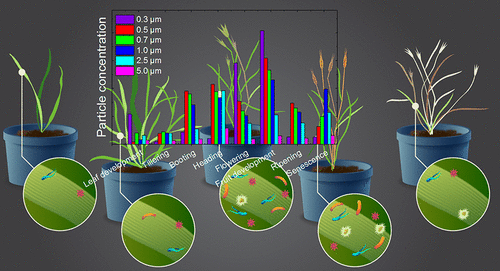当前位置:
X-MOL 学术
›
ACS Earth Space Chem.
›
论文详情
Our official English website, www.x-mol.net, welcomes your
feedback! (Note: you will need to create a separate account there.)
Microanalysis of Primary Biological Particles from Model Grass over Its Life Cycle
ACS Earth and Space Chemistry ( IF 2.9 ) Pub Date : 2020-08-31 , DOI: 10.1021/acsearthspacechem.0c00144 Swarup China 1 , Daniel Veghte 1, 2 , Amir H. Ahkami 1 , Johannes Weis 3 , Christer Jansson 1 , Alex B. Guenther 4 , Mary K. Gilles 3 , Alexander Laskin 5
ACS Earth and Space Chemistry ( IF 2.9 ) Pub Date : 2020-08-31 , DOI: 10.1021/acsearthspacechem.0c00144 Swarup China 1 , Daniel Veghte 1, 2 , Amir H. Ahkami 1 , Johannes Weis 3 , Christer Jansson 1 , Alex B. Guenther 4 , Mary K. Gilles 3 , Alexander Laskin 5
Affiliation

|
Airborne biological aerosols are an integral part of the atmosphere–biosphere interface and significantly impact the environment and Earth’s climate. Primary biological particles such as fungal spores, bacteria, and fragments of plant debris are emitted directly from the biosphere into the atmosphere. The phyllosphere (aboveground plant surfaces) is one of the major habitats for different microbes. In this study, atmospheric emissions of primary biological particles from model grass Brachypodium distachyon were monitored by online particle number concentration counting at eight principal growth stages starting from leaf development to senescence. Particles collected at each of the growth stages were then characterized using microspectroscopy techniques. Our findings indicate that the morphological and compositional characteristics of emitted biological particles are highly variable at the different growth stages. We identified fungal spores as the most abundant biological particles in the heading stage, while bacteria were most abundant in the flowering and fruit development stages. Understanding differences in the composition and morphology of biological particles during the plant life cycle provides more accurate and reliable insights on structural, functional, and biochemical properties of plant systems, as well as their interactions with microbial communities. This study also provides insights into Earth geoscience system models that represent primary biological particle emissions from the biosphere.
中文翻译:

生命周期模型草中主要生物颗粒的微观分析
空气传播的生物气溶胶是大气-生物圈界面不可或缺的一部分,对环境和地球的气候有重大影响。诸如真菌孢子,细菌和植物碎片碎片的主要生物颗粒直接从生物圈排放到大气中。叶圈(植物地上表面)是不同微生物的主要栖息地之一。在这项研究中,来自模型草短螺旋体distachyon的主要生物颗粒的大气排放通过从叶片发育到衰老的八个主要生长阶段的在线颗粒数浓度计数来监测烟粉虱。然后使用显微光谱技术表征在每个生长阶段收集的颗粒。我们的发现表明,在不同的生长阶段,发出的生物颗粒的形态和组成特征变化很大。我们确定真菌孢子在抽穗期是最丰富的生物颗粒,而细菌在开花和果实发育期是最丰富的。了解植物生命周期中生物颗粒的组成和形态的差异,可以更准确,更可靠地了解植物系统的结构,功能和生化特性,以及它们与微生物群落的相互作用。这项研究还提供了对代表地球生物圈主要生物颗粒排放的地球地球科学系统模型的见解。
更新日期:2020-10-16
中文翻译:

生命周期模型草中主要生物颗粒的微观分析
空气传播的生物气溶胶是大气-生物圈界面不可或缺的一部分,对环境和地球的气候有重大影响。诸如真菌孢子,细菌和植物碎片碎片的主要生物颗粒直接从生物圈排放到大气中。叶圈(植物地上表面)是不同微生物的主要栖息地之一。在这项研究中,来自模型草短螺旋体distachyon的主要生物颗粒的大气排放通过从叶片发育到衰老的八个主要生长阶段的在线颗粒数浓度计数来监测烟粉虱。然后使用显微光谱技术表征在每个生长阶段收集的颗粒。我们的发现表明,在不同的生长阶段,发出的生物颗粒的形态和组成特征变化很大。我们确定真菌孢子在抽穗期是最丰富的生物颗粒,而细菌在开花和果实发育期是最丰富的。了解植物生命周期中生物颗粒的组成和形态的差异,可以更准确,更可靠地了解植物系统的结构,功能和生化特性,以及它们与微生物群落的相互作用。这项研究还提供了对代表地球生物圈主要生物颗粒排放的地球地球科学系统模型的见解。











































 京公网安备 11010802027423号
京公网安备 11010802027423号